This was published 6 years ago
The Peninsula Hotel and the Battle of Hong Kong: The hotel room that changed Hong Kong's history
By Anthony Dennis
When the Japanese conquered Hong Kong 75 years ago, following the brief but fiercely fought Battle of Hong Kong, a precursor to the Fall of Singapore, they chose one of the most potent symbols of British colonial pride for the humiliating signing of the surrender documents. It was a room on the third floor of the Peninsula Hotel, the Queen of Kowloon, which had opened less than a decade and a half before, which the conquering Japanese forces would soon occupy and rename "Toa (or East Asia) Hotel".
They would fill the hotel with high-ranking officers and officials as well as one very special "guest", Sir Mark Aitchison Young, the British governor at the time of the Battle of Hong Kong. He would be held in one of the suites for two months before being transferred to Shanghai where he was mistreated by the Japanese during his incarceration.
Perhaps because of such a litany of other epochal events – such as the Chinese Communist Revolution of 1949, the Cultural Revolution and the 1997 handover from Britain to China – that have affected or befallen it in the decades since World War II, Hong Kong can tend to overlook or undervalue aspects of its past.
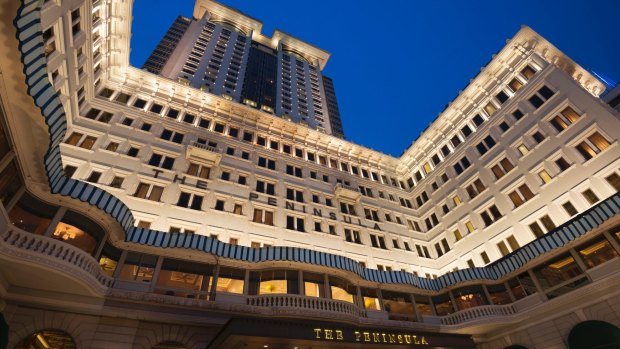
The Peninsula Hotel, Hong Kong.Credit: Getty Images
It was only relatively recently, after all, that the Kadoorie family – owners of the Peninsula since it opened in 1928 – after carefully studying blueprints of the hotel, were able to re-establish the location of the exact room – 336 – where the ceremony of the signing of the surrender documents was staged. But you won't find a plaque in or outside the room because management is reluctant to draw crowds around such a dark moment in Hong Kong, let alone to possibly discomfort Japanese guests or perhaps even British ones.
Hong Kong's mild dose of historical amnesia doesn't end at "the Pen", described in its heyday as "the finest hotel east of the Suez" and still one of Asia's premier hotels. On the other side of Victoria Harbour, which this grandest of grande dame hotels faces, on Hong Kong Island, is another, until recently, forgotten relic of the Battle of Hong Kong, which took place between December 8 and December 25, 1941.
See also: Twelve surprising things I learned working as a butler at a big New York hotel
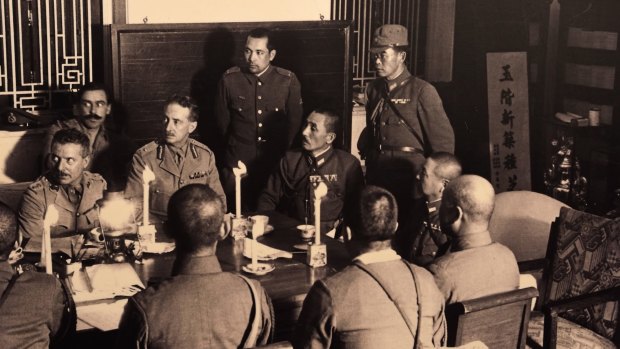
The Japanese occupation of Hong Kong began when the Governor of Hong Kong, Sir Mark Young, surrendered the British Crown colony of Hong Kong to Imperial Japan.Credit: Alamy
It's the little-known Mount Davis Battery on the westernmost end of Victoria, just above Kennedy Town, one of modern-day Hong Kong's hippest haunts. Built in the early 20th century to defend the western extremities of Hong Kong Island, it wasn't until the invasion by the Japanese soon after the attack on Pearl Harbour on December 7, 1941, that the Mount Davis Battery realised its purpose. It was heavily bombarded by the Japanese as they began their long and bloody conquering rampage through Asia.
Despite the part it played in the desperate defence of the then British colony, the full extent of Mount Davis Battery, abandoned, vandalised and buried beneath decades of overgrown vegetation was largely forgotten. That is, until it was effectively rediscovered in recent years by a group of Hong Kong history enthusiasts. They set about removing the dense overgrowth that had enveloped the site, eventually revealing a complex that included five gun emplacements, Western Fire Command Headquarters, ammunition stores and barracks.
Now you can take a fascinating, and surprisingly scenic, hiking tour of the ruins of Mount Davis Battery, with Eco Travel Limited, a local tour company. Named after John Francis Davis, the second governor of Hong Kong between 1844 and 1848, the views from the eponymous hill of Victoria Harbour, of outlying islands and the South China Sea are superb and are among the best in Hong Kong with none of the tourist crowds.
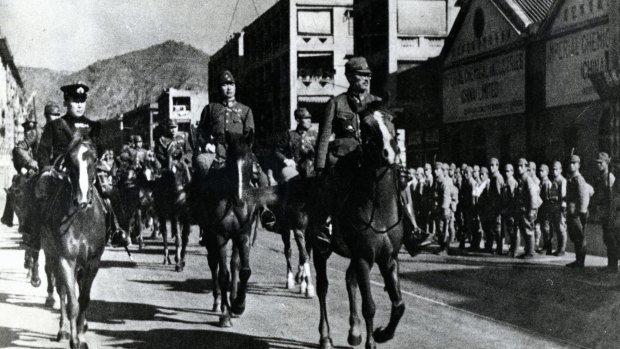
Lieutenant-General Takashi Sakai (right) on horseback after the Battle of Hong Kong on December 28, 1941 in Hong Kong.Credit: The Asahi Shimbun
But, captivating as the vistas may be – and with a humble youth hostel at Mount Davis now enjoying one of the best locations for accommodation in Hong Kong – the real purpose of our tour is to inspect the World War II ruins. From the observatory deck below, owned by the Hong Kong Jockey Club Youth Hostel with its 270-degree views, we set out to explore the ruins.
On the way to visiting a massive centrepiece gun emplacement, our group walks across an erstwhile parade ground where anti-aircraft guns were placed to shoot down Japanese fighter and bomber aircraft. Here you need to employ your imagination as any records of the precise purpose of each building have been lost. Yet among the former ammunition stores and command posts you gain a real sense of what it must have been like to have come under constant attack from Japanese aircraft.
Unlike the fight for Singapore, few Australians took part in the Battle of Hong Kong with the British forces bolstered by Indians and Canadians, with the unsuccessful campaign representing Canada's first foray into the then newly declared war in the Pacific. But, while the British elsewhere in Asia were deludedly confident in defending Singapore against the Japanese, the Battle of Hong Kong demonstrated the formidable and ruthless fighting abilities of the Japanese.
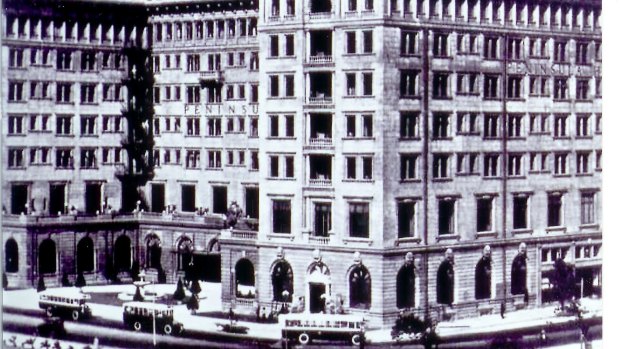
A historic photo of The Peninsula Hotel, Hong Kong.
See also: Twenty amazing hotels that could change your life
Eventually, after incessant bombardment throughout December 1941, the order was given to destroy all equipment at Mount Davis, lest it fall into Japanese hands, and withdraw. By the time of the surrender, nearly 5000 combatants on both sides were killed as well as 4000 civilians with thousands more wounded and about 10,000 British, Canadian and Indian troops captured by the Japanese.
The bodies of many of the fallen were buried at the other side of Victoria at the hillside Stanley Military Cemetery. Among the most moving aspects of the cemetery today are the rough-hewn gravestones, interspersed with more formal memorials, with hand-carved inscriptions that were fashioned by prisoners-of-wars in recognition of their own dead under Japanese captivity.
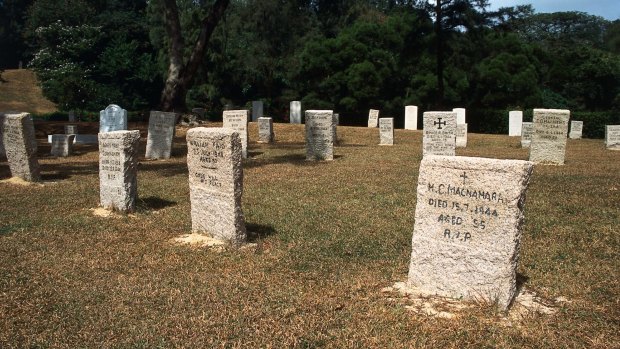
Headstones in the Stanley Military Cemetery.Credit: Nigel Hicks
The occupation of Hong Kong by the Japanese was a brutal one, beginning with a massacre by drunken Japanese troops at the St Stephens College at Stanley, where a British field hospital had been established. Nurses were raped and murdered with wounded soldiers bayoneted in their hospital beds. Thousands of women were raped and food shortages during the occupation saw Hong Kong's population decline by a million, with the Japanese deporting many Hong Kongers across the border to China.
One other major casualty of the war was the Peninsula Hotel itself. Following the surrender of the Japanese, it was eventually reclaimed by its original and present-day owners, the Kadoorie family. The hotel was described as being in a decrepit state by the time British rule was restored with the former Australian manager, Aubrey Diamond, heading straight to the Peninsula after his release from prison at Stanley where he had been incarcerated by the Japanese.
After the hotel had been requisitioned for a period to house war refugees, it was eventually returned to the Kadoorie company, Hong Kong and Shanghai Hotels Ltd a year after the war and there was the opportunity to uncover a precious art work that the family had hidden from the Japanese under the lift shaft of the separate, and since demolished, St George's Building elsewhere in Hong Kong
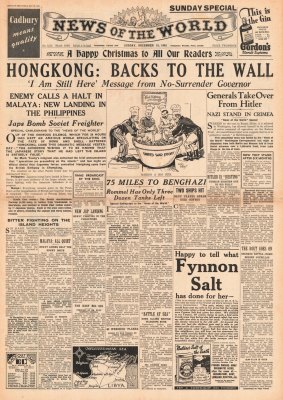
Front page of News of the World Battle for Hong Kong.Credit: Alamy
The piece was a priceless 17th-century Coromandel screen, depicting Emperor K'ang Hsi and his consort in the Summer Palace. It was eventually put on display back at the Peninsula where it remains today, in pride of place inside Gaddi's, the hotel's outstanding modern French restaurant, named after Leo Gaddi, the hotel's first post-war general manager.
See also: Singapore's most famous hotel to close until mid-2018
FIVE MORE WORLD WAR II SITES IN HONG KONG
KAMIKAZE CAVE, LAMMA ISLAND
The Kamikaze Cave was of strategic importance to the occupying Japanese kamikaze team based in Hong Kong during World War II. Speedboats, deployed to attack Allied ships as part of suicide missions, were concealed there. See discoverhongkong.com
SHING MUN WAR RELICS TRAIL
Located in Hong Kong's New Territories, this trail established by Hong Kong's Agriculture, Fisheries and Agriculture Department includes ruins of tunnels, pillboxes, bunkers and observation posts built by the British in the years before World War II and used in the defence of Hong Kong. See discoverhongkong.com
STANLEY MILITARY CEMETERY
An easy walk from the town of Stanley in the southern part of Hong Kong, this cemetery is built on a hillside. Although it's ostensibly a formal World War II military cemetery, civilians who died before and during the Japanese occupation are also buried there. See cwgc.org
SAI WAN WAR CEMETERY
A Commonwealth War Grave, Sai Wan War Cemetery is in the north-east of the island of Hong Kong, about 11 kilometres from Central on Hong Kong Island. At the entrance to the cemetery is an imposing memorial to those who died at the hands of the Japanese and who have no known grave. See cwgc.org
TAI O HERITAGE HOTEL
A restored colonial-era former police station on a point near the quaint fishing village of Tai O, this now modern-day hotel was occupied by the Japanese between 1941 and 1944 with local residents forced to serve as policemen under their occupiers. See taioheritagehotel.com
TRIP NOTES
MORE
FLY
Cathay Pacific operates more than 70 flights a week to Hong Kong from six major Australian cities with four flights daily from Sydney and three daily from Melbourne. See cathaypacific.com/AU
STAY
The Peninsula Hong Kong is at Salisbury Road, Kowloon. Doubles from $HKD4880 a night. See hongkong.peninsula.com.
TOUR
Eco Travel Limited runs a four-hour Mount Davis Military History guided tour. The tour costs $HK380 a person and includes transportation to and from Sheung Wan in Central. See hongkong.ecotravel.hk .The website of the Hong Kong Tourism Board has information on other wartime tours. See discoverhongkong.com
Anthony Dennis visited as a guest of the Hong Kong Tourism Board,. Cathay Pacific and the Peninsula Hong Kong.
Sign up for the Traveller Deals newsletter
Get exclusive travel deals delivered straight to your inbox. Sign up now.